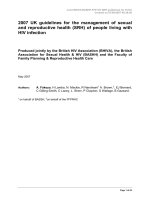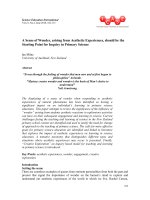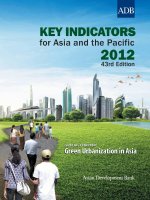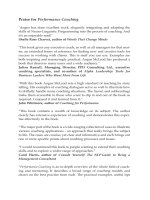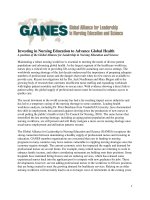Timeshare Management: The key issues for hospitality managers (Hospitality, Leisure and Tourism)
Bạn đang xem bản rút gọn của tài liệu. Xem và tải ngay bản đầy đủ của tài liệu tại đây (1.35 MB, 225 trang )
Timeshare Management: The Key Issues
of Hospitality Managers
This page intentionally left blank
Timeshare Management: The Key
Issues of Hospitality Managers
Tammie J. Kaufmann
Conrad Lashley
Lisa Ann Schreier
AMSTERDAM $ BOSTON $ HEIDELBERG $ LONDON $ NEW YORK $ OXFORD $ PARIS $ SAN DIEGO $
SAN FRANCISCO $ SINGAPORE $SYDNEY $ TOKYO
Butterworth-Heinemann is an imprint of Elsevier
Butterworth-Heinemann is an imprint of Elsevier
Linacre House, Jordan Hill, Oxford OX2 8DP, UK
30 Corporate Drive, Suite 400, Burlington, MA 01803, USA
First edition 2009
Copyright Ó 2009 Elsevier Inc. All rights reserved
No part of this publication may be reproduced, stored in a retrieval system or transmitted in any
form or by any means electronic, mechanical, photocopying, recording or otherwise without the
prior written permission of the publisher.
Permissions may be sought directly from Elsevier’s Science & Technology Rights Department in
Oxford, UK: phone (+44) (0) 1865 843830; fax: (+44) (0) 1865 853333; email: permissions
@elsevier.com. Alternatively you can submit your request online by visiting the Elsevier web site
at and selecting Obtaining permission to use Elsevier
material
Notice
No responsibility is assumed by the publisher for any injury and/or damage to persons or
property as a matter of products liability, negligence or otherwise, or from any use or operation of
any methods, products, instructions or ideas contained in the material herein.
British Library Cataloguing in Publication Data
A catalogue record for this book is available from the British Library
Library of Congress Cataloging-in-Publication Data
A catalog record for this book is available from the Library of Congress
ISBN: 978-0-75-068599-3
Printed and bound in the United Kingdom
09 10 10 9 8 7 6 5 4 3 2 1
For information on all Butterwoth-Heinemann
publications visit our website at books.elsevier.com
Contents
CHAPTER 1 Vacation ownership resort development: an overview
An introduction of vacation ownership and its history
Introduction 1
Timeshare Evolving 2
The Evolving Timeshare Service 5
Evolving Legal Approaches 6
Exchange Services 7
Resale 9
Resort Management 10
Movements and Developments 11
Summary 14
CHAPTER 2 The Vacation Owner
An overview of the demographics of vacation owners and
comparisons to the traditional hotel guest
Introduction 15
Timeshare Locations 16
Timeshare Market Segmentation 20
Summary 28
CHAPTER 3 The Community
A look at to the impact vacation ownership resorts have
on the community
Introduction 29
Impacts of the Vacation Ownership Industry 30
Timeshare Owner Impact and Visitor Behaviour 32
Employment Impact of the Timeshare Industry 38
Summary 41
v
CHAPTER 4 Marketing Vacation Ownership Resorts
Evaluate the proper application of marketing theory in the
vacation ownership industry
Introduction 43
The Marketing Mix 44
Marketing Timeshare 45
Vacation Ownership Marketing Practices 48
Owner Referral Program 53
Summary 57
CHAPTER 5 Sales
Evaluate current sales practices
Introduction 59
The 12-Step Sales Process 60
Summary 71
CHAPTER 6 The Sales Process: Later Stages
Introduction 73
Presentation and Uncovering of Problems 74
Property Viewing 79
Summary 87
CHAPTER 7 Points vs. Weeks
Explain the difference between points and weeks. Examine
both and how they are used effectively
Introduction 89
Fixed Timeshare Weeks 90
Home Resorts 94
Summary 102
CHAPTER 8 The Role of the Exchange company
Share information about exchange companies and their
role in the vacation ownership industry
Introduction 103
History of the Exchange Companies 104
Resorts Condominium International 104
How Do RCI Points Work? 109
Interval International 109
Boutique Exchange Companies 114
Summary 117
Contents
vi
CHAPTER 9 Financing in the Timeshare Industry
Explain types of financing involved in developing vacation
ownership resorts Explain types of financing consumer’s employ
when purchasing and the resorts involvement
Introduction 119
Developer Financing 120
Consumer Financing 124
Summary 126
CHAPTER 10 Service Quality Mangement
Application of service theory to the vacation ownership industry
Introduction 127
Timeshare Service Quality 130
Service Quality Management Systems 133
Quality Management and Timeshare Operations 137
Total Quality Unit Management 138
Hospitableness 141
Summary 143
CHAPTER 11 Human Resources
Explanation of unique issues and career opportunities within
vacation ownership
Introduction 145
Hospitality and Hospitableness 147
Emotional Dimensions of Hospitality and Tourism Service 150
Empowering Service Excellence 153
Managing as Though People Matter 157
Summary 165
CHAPTER 12 Condominium Hotels
Introduction of the concept of condominium hotels: reasons
behind the growth and comparisons to traditional vacation
ownership properties
Introduction 167
Condominium Hotels 168
Growth in Foreign Interest and Brands 172
Financing Condominium Hotels 176
Summary 181
Appendix 181
Contents vii
CHAPTER 13 Vacation ownership expansion
Explore the growth of vacation ownership into other segments
Introduction 185
Fractionals 186
Summary 192
Contents
viii
Acknowledgments
I would like to thank my family that supported my dreams (Alan, Celeste,
Jeff, Julie, Pam, John, Austin, Smylie, Francie, Luckie, and Sarah). I would
like to thank my graduate school advisor, Pamela Weaver that molded me
kicking and screaming into an academic. I would not be here without her
guidance. I would like to thank my chosen family in Orlando that coaxed me
along this journey and made me feel that I could accomplish this goal and
distracted me when I needed to get away from writing (Kimberly, Randy,
Dave, Denver, Duncan, Rose and Bill Jackson, and fortunately for me this list
is too long to include everyone). Finally, thank you Conrad and Lisa Ann you
have been a terrific team.
Tammie Kaufman
Writing this book has truly been a collaborative effort. Thanks to both
Conrad and Tammie for allowing me to contribute and to Sarah, Sunita and
everyone at Elsevier for seeing the need for this textbook and their assistance
in getting in published. I’d also like to thank those individuals within the
timeshare industry who encouraged me to learn and be a catalyst for positive
change. On a personal note, thanks to my family and friends for putting up
with yet another timeshare endeavour. Finally, to the students and other
readers of this textbook may it educate and enlighten you and open up
a world of possibilities for you.
Lisa Ann Schreier
ix
This page intentionally left blank
FOREWORD
After working through the foreword you should:
Understand timeshare service
Recognise the similarities and differences faced by the timeshare sector
Understand the structure of this book and the approach taken to the
study of timeshare services
Understanding Timeshare
Timeshare is a relatively recent business format supporting hospitality and
tourism services. Put simply, timeshare formats allow customers to access
the right to accommodation within and between countries. The timeshare
owner buys accommodation of a certain quality for a given period of time.
There are a number of different schemes but the most simple and original
format involves the timeshare owner buyin g the right to stay in particular
lodge or apartment in the same resort for a fixed week each year. Rather than
buying the lodge or apartment, the timeshare owner buys a part of it which
allows them to use the unit for an agreed amount of time each year.
In many ways, the timeshare approach recognises the fears and uncertainties
involved in travel, particularly when undertaken internationally. Times hare
enables travellers to return regularly to a place they know and love, and to
a property that represents their home away from home. For some it involves
holidaying in an area or country from which they originate, but now live
permanently elsewhere. For others, timeshare is simply establishing a home
from home in a location that is attractive to the owner. Whilst this ‘home
from home’ set of motives are still important for many owners, there has
been, over recent years, a growing interest more flexible packages which
either do not tie the buyer into a particular location, or are linked to extensive
exchange networks which allow owners in one location to swap their weeks
to another resort, within countries and across international borders.
As a new business format, the popular image of timeshare has had its ups and
downs. In some cases, rogue traders using high pressure selling techniques
have created a bad media image of timeshare sales. Complaints from buyers,
or would be buyers, about misleading information, and sales presentations
that used bullying tactics helped to create an early impression that time share
was somehow based on a scam or dodgy at best. In response to some of
these early concerns, industry in the USA and Europe have set up trade
xi
associations which lay down some minimal trading standards to which
member companies have to adhere. One important recommendation has
been to a minimum ‘cooling off’ period during which ‘would be buyers’ are
able to formally withdraw from a previously signed agreement. In some cases,
individual US states, and the European Union have imposed minimum
cooling off periods. In addition to these organisational and legislative
attempts to provide more consumer protection, many of the larger hotel
companies have now entered the timeshare market. Firms like Marriott,
Hilton and De Vere now own cons iderable portfolios of timeshare properties.
Frequently they will develop new sites and resorts with a mixture of hotel and
timeshare properties. These firms have pressed for more professional oper-
ating standards, as dissatisfied timeshare customers would reflect badly on
their hotel operations.
This book aims to provide an introduction to the study of timeshare business
operations. It is written with both students and industry practitioners in
mind, and focuses on the practical aspects of the timeshare bu siness. The text
starts with an overview of the timeshare business, origins and growth as well
as developments and trends. It shows that timeshare properties are located in
around 100 countries. Ownership is also global, but very much concentrated
in just three countries. The USA, Ger many and the United Kingdom between
are home to over 60 per cent of the world’s timeshare owners. The commu-
nication chapter follow s these chapters which establish ownerships patterns
and trends, shows how the patterns of ownership vary and change over time.
The next three chapters explore the marketing of timeshare and changes in
the approach to marketing timeshare followed by a detail discussion of sales
presentations to interested clients. The next three chapters explore some of
the practical mechanics in various formats that timeshare can take, together
with the role of exchange companies and financing arrangements used by
different organisations. Service quality management and the management of
human resources, as essential elements of the customer offer, are the subject
of the next two chapters. The last two chapters explore variations in the
accommodation sector by discussing the development of condominium
hotels and other developments in the timeshare model.
As an introductory study in timeshare the book is written in a simple style
with some references and academic structures, but these are kept to
a minimum. The book is also written in a way that encourages the reader to
be actively involved in the reading process. Case studies and concrete
examples are provided throughout the book. The use of reflective practise
sections also invite the reader to stop and think about the implications of
what has just been discussed. Key learning points aim to reinforce learning
taking place. The book, therefore, introduces the topic of timeshare, but it
also aims to introduce the reader to academic study and style.
The dominant learning style of readers is also one important consideration
by the authors. Prior research shows that many of the readers are likely to
Foreword
xii
have a learning style which is know as Activist according the work of Honey
and Mumford (1983 ). Without wishing to run through the whole model it is
worth reiterating that Activist learners learn best by doing and feeling, and
talking with others. They rely more on intuition than on analysis. They need
to see the practical application of knowledge. They enjoy here and now
activities, such as business games, teamwork tasks and role-plays. They are
particularly keen to learn by ‘doing’, and typically find theoretical approaches
difficult. They are attracted to ‘people’ industries and like active involve-
ment. They work well with others. They will try new ideas. They like variety
and excitement. However, they experience difficulties that many experienced
educators will recognise. They rarely plan their actions. They rush into
answers, and in examination situations may run out of time because they
spend too much time on the early questions. They tend not to put effort into
topics are not of interest and they often lea ve things to the last minute.
For the purposes of this book, and for future activities, we suggest that the
process of learning needs to move through the stages outline on Kolb’s
model. Active experience need to be followed by reflection including the
critical evaluation of the experience ; and consideration of how these expe-
riences inform or adapt theoretical understanding; and how this might
inform future actions, hence, the approach taken in the book. We wish to
encourage effective learning by ensuring that the reading process actively
engages reflections and critical thinking. We hope, therefore, that the book is
instructive and enjoyable,
Conrad Lashley,
Tammie Kaufman,
Lisa Ann Schreier
Foreword xiii
This page intentionally left blank
CHAPTER 1
Vacation Ownership Resort
Development: An Overview
After working through this chapter, you should be able to
- Understand the concept of timeshare offer
- Understand that the operations cover a variety of facilities and services
- Recognize that timeshare offers have evolved and changed over time
- Understand that new entrants into the market have increased the
professionalism of the sector
INTRODUCTION
The timeshare industry is one of the newest and fastest growing sectors of
the international hospitality and tourism experience. Although known as
vacation ownership in some quarters, timeshare is the most widely used term
to describe the purchase of time periods in locations of choice. The original
model involved buying set weeks in a given accommodation in a specific
resort, though this model has now been adapted and amended.
The timeshare industry first emerged significantly in Europe in the
1960s. One of the earliest examples emerged in a skiing resort in France. The
skiers were wanting to ensure guaranteed accommodation for skiing. Prop-
erty owners found that they could sell their rights to have acce ss to the same
accommodation across the year. Very soon, various US resorts began to sell
timeshare weeks in their resorts. Since the 1970s, timeshare has evolved
through different international resort locations and resort types, number of
resorts, number of owners and variations in the nature of the timeshare offer.
Timeshare Management
Copyright Ó 2009 by Elsevier Inc. All rights of reproduction in any form reserved.
CONTENTS
Introduction
Timeshare Evolving
The Evolving
Timeshare Service
Evolving Legal
Approaches
Exchange Services
Resale
Resort Management
Movements and
Developments
Summary
1
TIMESHARE EVOLVING
Timeshare evolved as a form of second home ownership with limited rights
of access, and also relieved the timeshare owner of the full annual costs of
maintaining the property because it is shared with other owners over the
year. The term ‘timeshare’ includes ‘time’ and ‘share’ indicating that the
approach, in principle, involves sharing time in a given space. Consumer
motives and segmentation are discussed more fully in Chapter 2, but since
their introduction in skiing villages in France and in Switzerland, time share
can be found for a range of resorts across the globe. Table 1.1 lists the
different types of resorts in which various forms of timeshare offers are
found. Each resort offers a number of different benefits which are likely to
appeal to differing lifestyles.
In fact, the first timeshare operation was begun in the 1950s in Europe by
a Swiss company known as Hapimag. They sold shares in their hotel and
used the proceeds to buy holiday accommodation across Europe. The
‘shareholders’ had the right to use these properties on a regular basis.
- The benefits to the shareholder are that they can get regular access
to properties which they know and trust.
- They are aware of the quality and service standards, as well as the
location.
- The hotelier is able to raise capital with which to expand.
- The hotelier overcomes problems relating to accommodation – the
space is sold even if the individual timeshare does not materialise that
year.
Table 1.1 Timeshare Resort Types
Resort Type
Seaside/ocean
Regional
Golf
Snow/ski
Lake/river
Urban
Theme park
Casino/gambling
Other
Source: Ernst & Young, 2006:15
CHAPTER 1: Vacation Ownership Resort Development: An Overview
2
In the 1970s, US property developers were going through a crisis and were
looking for innovative ways to sell properties. The fact that they were selling
properties in a way that opened up property purchase to a larger number of
people meant that there were more buyers. They had to increase and change
marketing and sales activities, because they were now selling the same
apartment 52 times each week of the year. Most importantly, they released
the capital value of the property for f urther property development.
At a similar time, timeshare owners in the US began to swap and
exchange visits to different resorts, first on an informal basis, but later this
resulted in the formation of Resort Condominiums International (RCI) as an
organization devoted to enabling exchanges. Later, Interval International (II)
was created also enabling exchanges of weeks and resorts among timeshare
owners.
Independently of these developments in the USA, timeshare began to
develop in the UK, France, Italy and in Scandinavia. Initially, the majority of
sales were to British citizens buying properties in their favourite resort
destinations in Spain. Europe is now the second largest timeshare market in
the world after the USA. Table 1.2 provides an overview of estimates of the
world market based on the number of resorts.
The point to note here is that these figures are taken for slightly different
time periods, as it is difficult to get hold of accurate up-to-date figures for
global timeshare resorts, and even the European figures are somewhat out of
date. However, they do show that the majority of timeshare resorts are
located in the USA and Europe, and that most timeshare owners are located
in the same two continents. Using these figures, 70 per cent of timeshare
resorts are located in the USA or in Europe and the OTE (2002: 9) states that
some 74 percent are resident in the two continents.
Key point 1.1
Timeshare evolved in the latter part of the twentieth century to provide a form of
holiday resort ownership based on the purchase of time periods.
Reflective practice 1.1
a] Consider what the strengths and weaknesses of owning a timeshare property
might be.
b] Consider the strengths and weaknesses from the resort developer’s perspective.
Timeshare Evolving 3
In the early stages, most timeshare development companies were inde-
pendents, and sales techniques were not always ethical. High pressure
selling, and some instances of fraudulent selling meant that the industry
developed a dodgy reputation. However, this began to change when some of
the larger property development and internatio nal hotel chains began to
enter the market. Table 1.3 lists some of the recent entrants into the time-
share market in Europe.
As more corporate players have entered the field, there has been an
increasing concern to tidy up the trading practices of timeshare operators.
Sales techniques in particular have been a major focus. Allowing a cooling-off
period between the sales presentation and acceptance and final confirmati on
has been a particular concern in many countries. The OTE’s Code of Ethics
requires all members to build in a period between signing a contract to
purchasing a timeshare interval, and the agreement becoming binding;
typically in the EU this is about 10 days. In the USA, this is called ‘Rescission
rights’, that is, the right to withdraw from a signed contract within a fixed
period.
Both the American Resort Development Association and the Organiza-
tion Timeshare Europe have developed codes of practice binding on mem-
bers. Apart from the requirements for ‘rescission periods’ or cooling-off
Table 1.2 Estimates of the Number of Timeshare Resorts
Global Number of Resorts Resorts Based in the USA Resorts Based in Europe
4325 1604 1452
Source: see Chapter 2, Table 2.1
Table 1.3 Recent Entrants into the Timeshare Market
Timeshare Companies Main Business Country of Origin
Barratt Group Property developer Britain
Metro Group Supplies and property Germany
Club Mediterrannee Resorts France
Berlusconi Group Conglomerate Italy
Sol Hotel Group Hotels France
Hilton Hotels Britain/USA
De Vere Group Hotels UK
Disney Resorts USA
TUI Resorts Britain
CHAPTER 1: Vacation Ownership Resort Development: An Overview
4
period most of these codes tread a line between trying not to stifle genuine
entrepreneurial activity and protecting potential owners from high pressure
or dishonest selling. In principle, they offer a code of conduct which sets
baseline standards to protect reputable firms from the antics of some rogue
traders but which do not restrict free enterprise. Hence, they are almost
exclusively concerned with the protection of potential timeshare owners
and rarely consider other interest groups such as employees, or the local
communities in which resorts are located (Upchurch & Lashley, 2007).
THE EVOLVING TIMESHARE SERVICE
In the early stages, time share owners bought a fixed week in a fixed property
unit (fully appointed luxury apartment, villa, cottage or suite) for a fixed
week(s) in high, medium, or low season bands in a given resort. This is
described in Table 1.4 as ‘Fixed unit/fixed interval’.
Over the years, more flexibility has been built into the offer to consumers.
- The ‘Fixed unit/float interval’ involves purchase of a time period
in a fixed unit, but this might float with regard to week(s) taken,
though these are likely to be taken at high, medium or low season.
- In some cases, timeshare owners buy a set period of time but are not tied
into availing themselves of that period in the same unit, or in the same
resort. These are referred to as a ‘Float unit/fixed interval’ in the table.
Table 1.4 Variations in the Timeshare Arrangement
Fixed unit/fixed interval
Fixed unit/float interval
Float unit/fixed interval
Fixed unit/float season
Float unit/float season
Points
Source: Ernst & Young, 2006:15
Key point 1.2
As timeshare has grown, trade bodies have developed to represent the sector and these
bodies have developed codes of practice protecting consumer interests which are
binding on their members.
The Evolving Timeshare Service 5
- A small number of timeshare relationships (see Ch apter 2) involve
having access to a fixed unit in different seasons. Typically, the
purchase of a high season week may result in access to several weeks in
the low season – referred to as a ‘Fixed unit/float season’inTable 1.4.
- One of the more flexible arrangements for owners involves a ‘Float
unit/float season’ whereby the arrangement allows timeshare owners
to vary between units, resorts and seasons.
- Finally, the ultimately flexible offer allows for the consumer to buy
enough ‘points’ to meet vacation needs. Disney was one of the first to
introduce the vacation club based on the purchase of points. This allows
the timeshare owner to purchase enough points to vary the
accommodation size in bedrooms or in seasons, or number of weeks
used.
EVOLVING LEGAL APPROACHES
Given the some what unusual nature of the timeshare unit purchaser and
the resort owner, a number of models for handling the legal relationship
have emerged. The three most common types of conveyance are (a) deeded
interests, (b) right to use, and (c) leasehold agreements.
1] Under a deeded interest method of conveyance, the purchaser
receives a title for the real property that is being purchased from the
timeshare developer. The unit owner, in effect, buys the right to use
Reflective practice 1.2
a] Consider the strengths and weaknesses of each of the above arrangements from the
timeshare consumer’s perspective.
b] How might these arrangements suit the needs of different kinds of timeshare
consumers?
c] Consider the strengths and weaknesses from the resort developer’s perspective.
Key point 1.3
The timeshare offer to consumers has evolved over time as some consumers have
asked for more flexibility in the timeshare experience.
CHAPTER 1: Vacation Ownership Resort Development: An Overview
6
that unit (apartment, etc.) in perpetuity. Like any bought object, it is
the owner’s rights to use it in perpetuity, sell it on and pocket the
proceeds and leave it to others as part of the estate, when the owner
dies. In effect, the resort developer sells the ownership of various time
periods for each unit.
2] The right-to -use type of conveyance is not associated with deeding
of the underlying real property to the purchaser; instead, the
individual is given contractual rights to use the timeshare facilities for
a specified period of time. Usually, this would involve the interval
purchased, say one week, but for time periods limited in the
agreement, say 25 years.
3] A leasehold agreement is similar to a right-to-use contract in that the
purchaser holds a leasehold interest or other interest of less than a full
ownership interest. In practical ter ms, this means that the purchaser
has the right to inhabit the timeshare unit for a specified period of
time, and at the termination of the lease, the property reverts to the
timeshare developer. Typically, the time period concerned is shorter
than with a right-to-use agreement.
Irrespective of the precise legal nature of the agreement, in effect the time-
share consumer is usually known as the owner. Any given deve loper can
build and sell an individual unit for 51 or 52 weeks out of a year, depending
on whether a week is held out for general maintenance purposes. Timeshare
offers are unique in both the hospitality and tourism sector and the property
ownership sector. In hotels, and in the accommodation sector, individuals
pay to use the unit for a specific time period, but this does not imply
ownership nor does it enable the guest to claim user rights over the same
time period.
EXCHANGE SERVICES
Whilst there are clearly different motives for owning a timeshare interval
(see Chapter 2) many owners are attracted to timeshare ownership because
Key point 1.4
A timeshare owner’s legal rights to the property vary according to the nature of the contract
established at the point of the initial sale. Not all agreements allow the owner to sell or
bequeath the property to heirs.
Exchange Services 7
there are opportunities to exch ange their interval at one of a number of
national or international resorts. Paradoxically, timeshare owners are buying
the right to access another home, but many do not want to be tied down to
just one location. That said, there are many who like the idea of returning to
the same location in the same week each year. However, for many, the
exchange allows the purchaser of one vacational period in a given resort for
the use of a vacant accommodation owned by someone at another time and/
or in another resort.
In most cases, a resort when developed becomes affiliated with one of the
major exchange companies which organizes the exchange transactions for
resort owners. In most resorts, this opportunity to exchange the bought
location and time period for another location or time period is the funda-
mental aspect of the offer. In fact, most developers will pay for the first year of
a two-year membership of the exchange company.
Two major organizations dominate the global vacation (timeshare)
exchange business:
- II is based in Miami, FL, and
- RCI has headquarters offices in Carmel, IN, and Parsippany, NJ.
RCI is the bigger organization with more affiliated resorts, consumers
serviced, a larger stock of weeks, as well as a larger number of confirmed
exchanges (ARDA, 2002). Collectively, these two exchange companies
service almost 6000 resorts with over four million members worldwide
(ARDA, 2002:181).
The exchange system allows timeshare owners to potentially trade their
interval for a similar interval in another resort within the exchange
organization’s books. Vacant units are not automatically made available to
exchange; the owner must formally put them in the company’s list of week
available. The exchange companies base their charges on entering the
registry. Charges are only made when there is take-up of that unit and that
week at that resort. The transaction fee (in addition to a membership fee) is
only charged when the exchange service is performed. Under a point
system, the interval is put into a program me which allows the member
(typically club members) to exchange the points purchased in a number of
ways.
These exchange organizations do not own resorts. II and RCI affiliate
resorts apply to be members into an exchange network. Given that the ability
to exchange the interval is a potential added benefit for many would-be
timeshare buyers, resort developers sign up their resorts to one or, in a few
cases, both of the exchange agencies. In addition, resort managers
CHAPTER 1: Vacation Ownership Resort Development: An Overview
8
automatically enrol all buyers in one or in some cases both of the exchange
agencies.
RESALE
The issue of resale has been something of a complicated matter, and highly
dependent on the legal format of the timeshare arrangement, as discussed
earlier. Under the deed of covenant or fee simple arrangement, the owner has
the right to sell the ownership like any purchased property. Under the right-
to-use arrangement or vacation club (points), no such right may exist. The
initial contract of agreement should clarify the position about resale. Under
most codes of conduct, the sales person is required to clarify these resale
rights, or limitations. ARDA (2002:196) suggests the foll owing as to why
timeshare (vacation) owners may want to sell.
1] Lifestyle change: death, retirement, change in family circumstances,
illness, retirement, change of residential location, children growing
up and moving away.
2] Owner’s death: This may be necessary to liquidate the owner’s assets.
3] Maintenance fee and other assessments: Owners believe that these
ongoing costs of maintaining access to the timeshare property are too
high and beyo nd their current financial resources.
4] Dissatisfaction with the product: It may be that the purchase and/or
the resort has not lived up to expectations.
5] Profit making: Where the owners can see the growing popularity of
the resort is increasing the market value of the properties in the resort,
they may decide to liquidate the value of the unit and take the profit.
Clearly the most important barrier to resale is the level of demand for
ownership of properties in the resort. Alongside the level of maintenance of
the property this will impact on the perceived value of the unit in comparison
Key point 1.5
Recognizing that many timeshare owners are interested in exchanging their timeshare
experiences, II and RCI have developed as the major international timeshare exchange
agencies.
Resale 9
to the purchase price. A well -maintained property in a highly sought after
resort will maintain if not increase its resale value and the number of
potential buyers.
RESORT MANAGEMENT
The resort developer usually handles the early stages of the resort develop-
ment, whilst the property is still being developed and the selling process is in
the initial phase. After these initial contacts with the resort sales and
marketing team, the owner’s main contacts are with the resort’s property
management company. There are three basic formats:
1] The resort developer can manag e the resort properties with
a contractual agreement with the resorts ‘timeshare owners
association’.
2] The timeshare owners as sociation may contract an outside firm to
manage the resort and maintain the properties.
3] The time share owners may decid e to manage the property internally.
Whichever of these formats is employed, the key focus of the actions is to
ensure that individual properties are kept to their original standard and that
wider resort facilities ar e both maintained and developed in line with the
resort owner’s expectations and needs. Within the unit, the maintenance
budget will be use d to keep the de
´
cor up to the standard, equipment serviced
and replaced, as well as maintain all furnishings. Given the potential change
in owners though sales, and the need to attract existing owners to use the
resort as well as attract them from other resorts that are exchanging into the
resort, the development and enhancement of facilities is highly important.
The responsibilities of the timeshare maintenance organization are likely
to include the following:
- The operation of the resort: This would include employing personnel
responsible for hospitality services, housekeeping, recreation and
leisure activities, food and beverage facilities, shops, etc. In other
words, this ensures that the property functions as a resort.
Key point 1.6
The right to resell the property is a function of the initial agreement. Where the right exists,
timeshare owners have the same rights to transfer ownership as with any other property.
CHAPTER 1: Vacation Ownership Resort Development: An Overview
10

